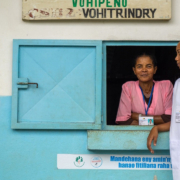Addressing Provider’s Perspectives and Barriers through Social and Behavior Change Approaches
Written by: Jvani Cabiness, Breakthrough ACTION Program Officer
Many factors are linked to the underutilization of modern contraception. For example, a service provider’s opinions, biases, attitudes, behaviors, capacity, skills, and working conditions can influence their ability or motivation to deliver quality services. Using advanced audience segmentation, human-centered design, and behavioral economics can generate new behavioral insights into providers, including helping identify positive deviants, addressing any bias toward young and/or unmarried women, and ensuring clients are counseled on all appropriate methods.
Breakthrough ACTION hosted a webinar in August 2018 to explore provider-side barriers and facilitators to method adoption and continuation. Presenters discussed how Transform/PHARE, Beyond Bias, and Breakthrough ACTION are using innovative social and behavior change (SBC) approaches to deepen understanding of provider’s attitudes and behaviors and their impact on their clients’ family planning choices.
The webinar showcased how important SBC is to improving service delivery and driving demand for family planning. Providers are gatekeepers and it is crucial that they serve as a bridge to services rather than a barrier. The better we understand the various perspectives, practices, and barriers that exist within provider communities, the more bridges we build.
Breakthrough ACTION is offering two new resources to support provider behavior change:
- Service Providers as an Audience for Behavior Change Trending Topic—Provides peer-reviewed literature, project examples, and program tools, including the Transform/PHAE provider behavior change mini toolkit with training videos and exercises.
- Provider Behavior Assessment How-to Guide—Provides overview guidance for identifying individual, interpersonal, organizational, and institutional factors contributing to provider behaviors. This guide is a work-in-progress and will continue to be developed as new insights emerge from ongoing provider behavior interventions.
We also invite you to share your experiences, ideas, and questions through Springboard.

 Center for Communication Programs/Photoshare
Center for Communication Programs/Photoshare Jonathan Torgovnik/Getty Images/Images of Empowerment
Jonathan Torgovnik/Getty Images/Images of Empowerment Photo credit: amy Rakotoniaina/PMI/Flickr
Photo credit: amy Rakotoniaina/PMI/Flickr Maddie Kau/ideas42
Maddie Kau/ideas42


